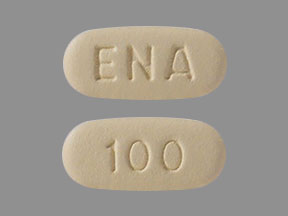Enasidenib Side Effects
Medically reviewed by Drugs.com. Last updated on Jan 13, 2024.
Applies to enasidenib: oral tablet.
Warning
Oral route (Tablet)
Patients treated with enasidenib have experienced symptoms of differentiation syndrome, which can be fatal if not treated. If differentiation syndrome is suspected, initiate corticosteroid therapy and hemodynamic monitoring until symptom resolution.Early recognition and aggressive management of differentiation syndrome is required to lessen the likelihood of serious illness and death. Symptoms of differentiation syndrome should be described to patients when starting therapy and at follow-up visits. Differentiation syndrome has occurred as early as 10 days and up to 5 months after initiating therapy.
Serious side effects of Enasidenib
Along with its needed effects, enasidenib may cause some unwanted effects. Although not all of these side effects may occur, if they do occur they may need medical attention.
Check with your doctor immediately if any of the following side effects occur while taking enasidenib:
More common
- Agitation
- blue lips, fingernails, or skin
- bone pain
- chest pain
- chills
- confusion
- cough
- coughing that sometimes produces a pink frothy sputum
- decreased awareness or responsiveness
- decreased urine output
- depression
- difficult or troubled breathing
- difficult, fast, noisy breathing
- dizziness
- eye pain
- fainting
- fast heartbeat
- fever
- general feeling of illness
- headache
- hostility
- increased sweating
- irregular, fast or slow, or shallow breathing
- irritability
- lightheadedness
- loss of consciousness
- muscle or joint pain
- muscle twitching
- nausea
- pale skin
- rapid weight gain
- rapid, shallow breathing
- seizures
- severe sleepiness
- sore throat
- swelling around the neck, groin, or underarm area
- swelling of the arms, feet, or lower legs
- swelling of the face, ankles, or hands
- unusual drowsiness, dullness, tiredness, weakness, or feeling of sluggishness
- yellow skin or eyes
Other side effects of Enasidenib
Some side effects of enasidenib may occur that usually do not need medical attention. These side effects may go away during treatment as your body adjusts to the medicine. Also, your health care professional may be able to tell you about ways to prevent or reduce some of these side effects.
Check with your health care professional if any of the following side effects continue or are bothersome or if you have any questions about them:
More common
For Healthcare Professionals
Applies to enasidenib: oral tablet.
General
The most common (30% or more) adverse reactions of any grade were elevated bilirubin, decreased calcium and potassium levels, nausea, diarrhea, vomiting, and decreased appetite.[Ref]
Hepatic
Very common (10% or more): Increased total bilirubin (81%)[Ref]
Metabolic
Very common (10% or more): Decreased calcium (74%), decreased potassium (41%), decreased appetite (34%), decreased phosphorus (27%)
Common (1% to 10%): Tumor lysis syndrome, decreased weight[Ref]
Gastrointestinal
Very common (10% or more): Nausea (50%), diarrhea (43%), vomiting (34%)
Common (1% to 10%): Abdominal pain[Ref]
Hematologic
Very common (10% or more): Differentiation syndrome (14%), noninfectious leukocytosis (12%)[Ref]
Nervous system
Very common (10% or more): Dysgeusia (12%)[Ref]
Dermatologic
Genitourinary
Common (1% to 10%): Increased uric acid[Ref]
Other
Common (1% to 10%): Pyrexia, peripheral edema[Ref]
Renal
Common (1% to 10%): Renal insufficiency[Ref]
Respiratory
Common (1% to 10%): Respiratory failure, dyspnea, hypoxia, pulmonary edema, acute respiratory distress syndrome[Ref]
Frequently asked questions
More about enasidenib
- Check interactions
- Compare alternatives
- Dosage information
- During pregnancy
- Drug class: miscellaneous antineoplastics
- Breastfeeding
- En español
Patient resources
Other brands
Professional resources
Other brands
Related treatment guides
References
1. Product Information. Idhifa (enasidenib). Celgene Corporation. 2017.
Further information
Always consult your healthcare provider to ensure the information displayed on this page applies to your personal circumstances.
Some side effects may not be reported. You may report them to the FDA.

